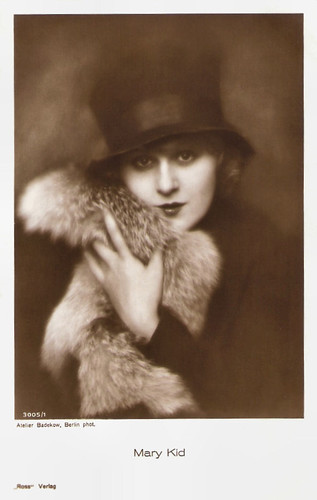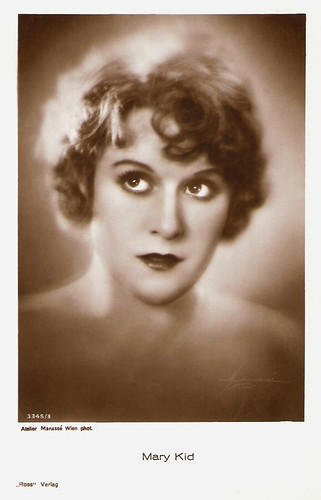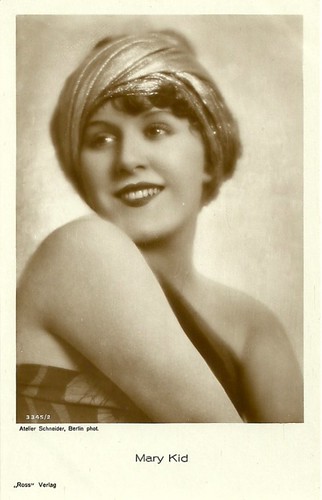Mary Kid (1901-1988) was a popular actress of the Austrian and German silent cinema. She also played in two early sound films in Italy.

German postcard by Ross Verlag, Berlin, no. 1615/1, 1927-1928. Photo: Atelier Bálazs, Berlin.

German postcard by Ross Verlag, Berlin, no. 1615/2, 1927-1928. Photo: Balázs, Berlin.

German postcard by Ross Verlag, Berlin, no. 3005/1, 1928-1929. Photo: Atelier Badekow, Berlin.

German postcard by Ross Verlag, no. 3345/3, 1928-1929. Photo: Atelier Manassé, Vienna.
Mary Kid was born Marie Anna Albertine Keul in Hamburg, Germany in 1901 (IMDb wrongly states 1904). Mary took theatre lessons in her hometown Hamburg, but before she could start a stage career there, the Austrian film producer Count Sascha Kolowrat took her to Vienna to turn her into a film star. For Sacha Film she played in three films directed by Mihaly Kertesz (the future Michael Curtiz): Namenlos/Der falsche Arzt/Nameless (1923), Die Lawine/The Avalanche (1923), and Harun al Raschid (1923-1924) – in which she had the female lead.
In 1924 Kid returned to Germany and continued her film career in Berlin, performing in around 25 films between 1924 and 1930. Her first German film was the comedy of morals Lumpen und Seide/Rags and Silk (Richard Oswald, 1924 in which she played opposite Reinhold Schünzel, Mary Parker and Johannes Riemann.
This was followed by more Richard Oswald films: Halbseide/Half-silk (1925), Vorderhaus und Hinterhaus/Front Building and House at the Back (1925) - both again with Mary Parker, Wir sind vom K.u.K. Infanterieregiment/We are from the K.u.K. Infantry regiment (1926), in which Kid had the female lead as Lily opposite Paul Heidemann, and Lützows wilde verwegene Jagd/Lützows wild bold hunt (1926-1927), a film set in Napoleon’s times in which Kid starred as an actress from the Viennese Burgtheater.
Mary Kid had more major roles in Sumpf und Moral/Marsh and Morality (Rudolf Walther-Fein, 1924) with Wilhelm Dieterle, Der Bastard/The Bastard (Gennaro Righelli, 1925) with Maria Jacobini, Zirkus Renz/Circus Renz (Wolfgang Neff, 1926), Heimliche Sünder (Franz Seitz sen., 1926), Ich war zu Heidelberg Student/I Was a Student at Heidelberg (Wolfgang Neff, 1926) – in which Kid had the female lead, Die Tochter des Kunstreiters/The Daughter of the Circus Rider (Siegfried Philippi, 1927), and Die Geliebte seiner Hoheit/The Lover of His Highness (Jakob & Luisa Fleck, 1927).
In Song/Schmutziges Geld (Richard Eichberg, 1928), Mary Kid played the evil antagonist Gloria who pushes knife thrower Jack (Heinrich George) to rob for her. When Jack is blinded because of the robbery Jack’s new friend Song (Anna May Wong) helps him out, pretending to be Gloria, but she pays for the disguise. She also appeared in Dornenweg einer Fürstin/Rasputin (Nikolaj Larin, 1928) in which Gregori Chmara played the notorious Russian monk.

German postcard. Photo: Westi, Berlin. Publicity still for Lumpen und Seide/Rags and Silk (Richard Oswald, 1925) with Ferdinand Bonn.

German postcard by Ross Verlag, no. 1076/1, 1927-1928. Photo: Alex Binder, Berlin.

German postcard by Ross Verlag, no. 1864/2, 1927-1928. Photo: Atelier Balázs, Berlin.

Italian postcard by Edizioni Aperol. Photo: Cines-Pittaluga, Roma.
Then Mary Kid returned to Vienna. During the last years of the silent era, she did various films there. In 1928 she starred in Die verschwundene Frau/The Woman Who Disappeared (Karl Hans Leiter, 1928) with Harry Halm and a young Peter Lorre, Die beiden Seehunde/The Two Seals (Max Neufeld, 1928) with Werner Pittschau, and Andere Frauen/Other Women (Heinz Hanus, 1928) with Rina De Liguoro.
In 1929 Mary Kid went back to Berlin to play in Die süsse Yvonne/Sweet Yvonne (Max Reichmann, 1929), in which Kid had the female lead opposite Fritz Schulz, and Der Leutnant ihrer Majestät/The Lieutenant of Her Majesty (Jakob & Luisa Fleck, 1929) starring Agnes Esterhazy as the Empress.
In Berlin, she also appeared in the First World War drama Die Herrin und ihre Knecht/The Boss and Her Servant (1929). Henny Porten stars as a German landlady who is helped by a Russian officer (Igo Sym) despite wartime, but is afraid he will choose her younger sister (Kid). She then must choose between love and patriotism. The film was directed by Kid’s old acquaintance Richard Oswald.
In 1930 Kid returned again to Vienna where she played in her last three silent films: General Babka (1930), directed by Hungarian director Desider/Deszö Kertesz, starring Wolf Albach-Retty, Eine Dirne ist ermordet worden/A Prostitute has been Murdered (Conrad Wiene, 1930), and Der Onkel aus Sumatra/The Uncle from Sumatra (Julius Szöreghy, 1930). In 1931 Kid went to Italy where she played in her only two sound films. The first was Rubacuori/Heartbreaker (Guido Brignone, 1931), a comedy about an old Casanova (Armando Falconi) who hunts young women until his wife (Tina Lattanzi) finds a jewel that belongs to one of his girlfriends. Falconi’s character comes between a prize fighter (Egon Stief) and his wife (Mary Kid).
Kid's second Italian film was Kennst Du das Land/Saltarello (Constantin J. David, 1931). Though produced by the Italian companies Pittaluga and Cines and shot by an Italian crew, the cast was German-Austrian. It was an alternative language version of Terra madre/Mother Earth (Alessandro Blasetti, 1931) starring Leda Gloria. After that, Mary Kid withdrew to her birth town Hamburg. There she died nearly sixty years later in 1988.

This is probably an Austrian postcard. Listo-Film was an Austrian film company. As no Listo-Film production with Kid is known at IMDb, Listo-Film may have been used as an Austrian distributor for one of Kid's German films.

German postcard by Ross Verlag, no. 3345/1, 1928-1929. Photo: Atelier Manassé, Vienna. Collection: Didier Hanson.

German postcard by Ross Verlag, no. 3345/2, 1928-1929. Photo: Atelier Schneider, Berlin.

Austrian postcard by Iris Verlag, no. 611. Sent by mail in 1932. Photo: Sascha.
Sources: Thomas Staedeli (Cyranos), Wikipedia (German), and IMDb.
This post was last updated on 24 December 2024.

German postcard by Ross Verlag, Berlin, no. 1615/1, 1927-1928. Photo: Atelier Bálazs, Berlin.

German postcard by Ross Verlag, Berlin, no. 1615/2, 1927-1928. Photo: Balázs, Berlin.

German postcard by Ross Verlag, Berlin, no. 3005/1, 1928-1929. Photo: Atelier Badekow, Berlin.

German postcard by Ross Verlag, no. 3345/3, 1928-1929. Photo: Atelier Manassé, Vienna.
Lured by a Count
Mary Kid was born Marie Anna Albertine Keul in Hamburg, Germany in 1901 (IMDb wrongly states 1904). Mary took theatre lessons in her hometown Hamburg, but before she could start a stage career there, the Austrian film producer Count Sascha Kolowrat took her to Vienna to turn her into a film star. For Sacha Film she played in three films directed by Mihaly Kertesz (the future Michael Curtiz): Namenlos/Der falsche Arzt/Nameless (1923), Die Lawine/The Avalanche (1923), and Harun al Raschid (1923-1924) – in which she had the female lead.
In 1924 Kid returned to Germany and continued her film career in Berlin, performing in around 25 films between 1924 and 1930. Her first German film was the comedy of morals Lumpen und Seide/Rags and Silk (Richard Oswald, 1924 in which she played opposite Reinhold Schünzel, Mary Parker and Johannes Riemann.
This was followed by more Richard Oswald films: Halbseide/Half-silk (1925), Vorderhaus und Hinterhaus/Front Building and House at the Back (1925) - both again with Mary Parker, Wir sind vom K.u.K. Infanterieregiment/We are from the K.u.K. Infantry regiment (1926), in which Kid had the female lead as Lily opposite Paul Heidemann, and Lützows wilde verwegene Jagd/Lützows wild bold hunt (1926-1927), a film set in Napoleon’s times in which Kid starred as an actress from the Viennese Burgtheater.
Mary Kid had more major roles in Sumpf und Moral/Marsh and Morality (Rudolf Walther-Fein, 1924) with Wilhelm Dieterle, Der Bastard/The Bastard (Gennaro Righelli, 1925) with Maria Jacobini, Zirkus Renz/Circus Renz (Wolfgang Neff, 1926), Heimliche Sünder (Franz Seitz sen., 1926), Ich war zu Heidelberg Student/I Was a Student at Heidelberg (Wolfgang Neff, 1926) – in which Kid had the female lead, Die Tochter des Kunstreiters/The Daughter of the Circus Rider (Siegfried Philippi, 1927), and Die Geliebte seiner Hoheit/The Lover of His Highness (Jakob & Luisa Fleck, 1927).
In Song/Schmutziges Geld (Richard Eichberg, 1928), Mary Kid played the evil antagonist Gloria who pushes knife thrower Jack (Heinrich George) to rob for her. When Jack is blinded because of the robbery Jack’s new friend Song (Anna May Wong) helps him out, pretending to be Gloria, but she pays for the disguise. She also appeared in Dornenweg einer Fürstin/Rasputin (Nikolaj Larin, 1928) in which Gregori Chmara played the notorious Russian monk.

German postcard. Photo: Westi, Berlin. Publicity still for Lumpen und Seide/Rags and Silk (Richard Oswald, 1925) with Ferdinand Bonn.

German postcard by Ross Verlag, no. 1076/1, 1927-1928. Photo: Alex Binder, Berlin.

German postcard by Ross Verlag, no. 1864/2, 1927-1928. Photo: Atelier Balázs, Berlin.

Italian postcard by Edizioni Aperol. Photo: Cines-Pittaluga, Roma.
Between Vienna and Berlin
Then Mary Kid returned to Vienna. During the last years of the silent era, she did various films there. In 1928 she starred in Die verschwundene Frau/The Woman Who Disappeared (Karl Hans Leiter, 1928) with Harry Halm and a young Peter Lorre, Die beiden Seehunde/The Two Seals (Max Neufeld, 1928) with Werner Pittschau, and Andere Frauen/Other Women (Heinz Hanus, 1928) with Rina De Liguoro.
In 1929 Mary Kid went back to Berlin to play in Die süsse Yvonne/Sweet Yvonne (Max Reichmann, 1929), in which Kid had the female lead opposite Fritz Schulz, and Der Leutnant ihrer Majestät/The Lieutenant of Her Majesty (Jakob & Luisa Fleck, 1929) starring Agnes Esterhazy as the Empress.
In Berlin, she also appeared in the First World War drama Die Herrin und ihre Knecht/The Boss and Her Servant (1929). Henny Porten stars as a German landlady who is helped by a Russian officer (Igo Sym) despite wartime, but is afraid he will choose her younger sister (Kid). She then must choose between love and patriotism. The film was directed by Kid’s old acquaintance Richard Oswald.
In 1930 Kid returned again to Vienna where she played in her last three silent films: General Babka (1930), directed by Hungarian director Desider/Deszö Kertesz, starring Wolf Albach-Retty, Eine Dirne ist ermordet worden/A Prostitute has been Murdered (Conrad Wiene, 1930), and Der Onkel aus Sumatra/The Uncle from Sumatra (Julius Szöreghy, 1930). In 1931 Kid went to Italy where she played in her only two sound films. The first was Rubacuori/Heartbreaker (Guido Brignone, 1931), a comedy about an old Casanova (Armando Falconi) who hunts young women until his wife (Tina Lattanzi) finds a jewel that belongs to one of his girlfriends. Falconi’s character comes between a prize fighter (Egon Stief) and his wife (Mary Kid).
Kid's second Italian film was Kennst Du das Land/Saltarello (Constantin J. David, 1931). Though produced by the Italian companies Pittaluga and Cines and shot by an Italian crew, the cast was German-Austrian. It was an alternative language version of Terra madre/Mother Earth (Alessandro Blasetti, 1931) starring Leda Gloria. After that, Mary Kid withdrew to her birth town Hamburg. There she died nearly sixty years later in 1988.

This is probably an Austrian postcard. Listo-Film was an Austrian film company. As no Listo-Film production with Kid is known at IMDb, Listo-Film may have been used as an Austrian distributor for one of Kid's German films.

German postcard by Ross Verlag, no. 3345/1, 1928-1929. Photo: Atelier Manassé, Vienna. Collection: Didier Hanson.

German postcard by Ross Verlag, no. 3345/2, 1928-1929. Photo: Atelier Schneider, Berlin.

Austrian postcard by Iris Verlag, no. 611. Sent by mail in 1932. Photo: Sascha.
Sources: Thomas Staedeli (Cyranos), Wikipedia (German), and IMDb.
This post was last updated on 24 December 2024.
1 comment:
Hi Bob
I work for the national daily newspaper The Daily Mail. Do you have a high resolution version of the Cliff Richard shot at this link please?
http://www.flickr.com/photos/truusbobjantoo/2387429341/
Our Editor likes it and would like to use it for a magazine cover. Please call me on +44 207 938 7157 as soon as possible. We need to know if its possible today 24th March 2011
Regards,
Lee
Post a Comment